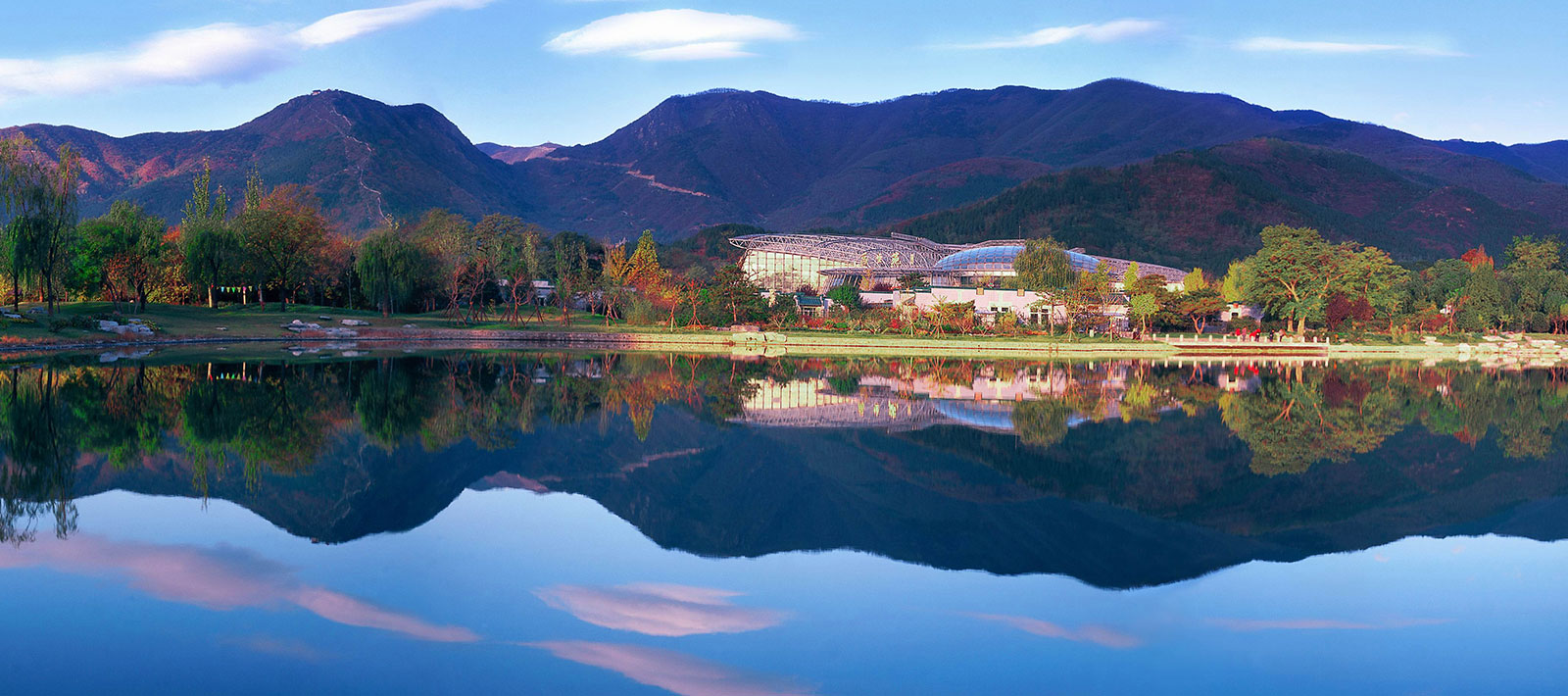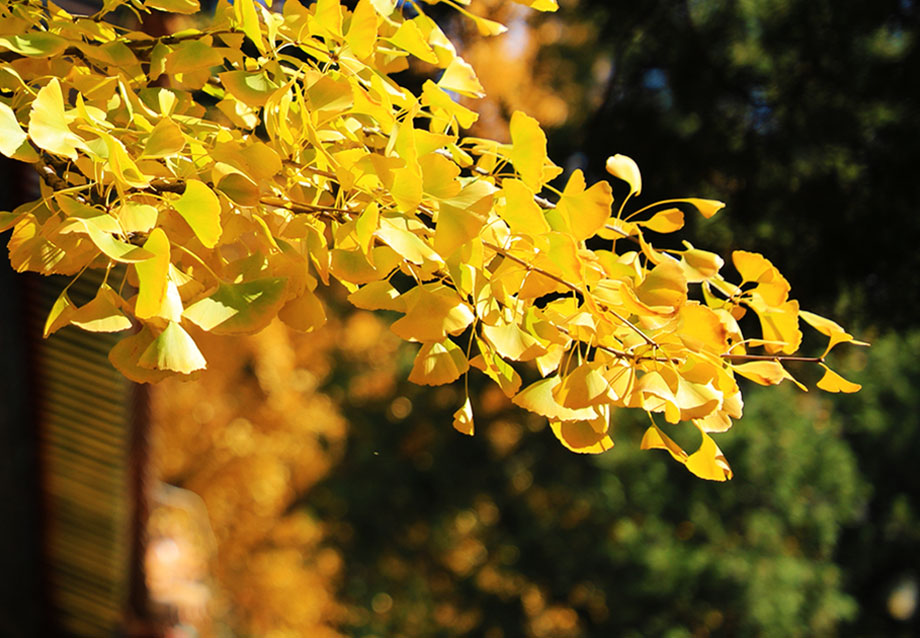Culture
Shifangpujue Temple (Wofo Temple)
Cherry Valley
Cao Xueqin Memorial
Memorial Pavilion of December 9th Movement
The Tomb of Celebrities
Stone Tablet Inscribed by Emperor Kang Xi
National Present
Shifangpujue Temple (Wofo Temple)
Shifangpujue Temple was initially built during the Zhenguan Period (627-649) in Tang Dynasty with a history of more than 1300 years. The original name of the temple was "Doushuai Temple" (Tuṣita in Sanskrit). A solid bronze statue of Sakyamuni, which is 5.3 meters long, 1.6 meters highweights about 54 tons, was cast in the temple in the first year of Zhizhi period (1321) in Yuan Dynasty. This extraordinary statue has been regarded as a rare treasure.
The temple was rebuilt, funded by the Prince Yi, Yunxiang during the Yongzheng period of Qing Dynasty. The Emperor Yongzheng bestowed the name of "Shifangpujue Temple"inscribed when it was completed in the 12th year of Yongzheng Period (1734). Cao Xueqin’s family had a close relationship with Prince Yis. Friends of Cao Xueqin described him as "Gone for poetic vervestayed in this temple", which indicated that he often lingered in temples in Xiangshan area, when he lived in Zhengbaiqi.
The temple was rebuilt by the Qing Government in the 48th years of Qianlong Period (1783)consequently formed the layout of what we see today. Its old cypress road, sal tree, bronze statue of Sakyamuni of Yuan Dynastyother beautiful landscapes have greatly impressed visitors,it is one of "Ten Famous Temples in China".
The temple was rebuilt, funded by the Prince Yi, Yunxiang during the Yongzheng period of Qing Dynasty. The Emperor Yongzheng bestowed the name of "Shifangpujue Temple"inscribed when it was completed in the 12th year of Yongzheng Period (1734). Cao Xueqin’s family had a close relationship with Prince Yis. Friends of Cao Xueqin described him as "Gone for poetic vervestayed in this temple", which indicated that he often lingered in temples in Xiangshan area, when he lived in Zhengbaiqi.
The temple was rebuilt by the Qing Government in the 48th years of Qianlong Period (1783)consequently formed the layout of what we see today. Its old cypress road, sal tree, bronze statue of Sakyamuni of Yuan Dynastyother beautiful landscapes have greatly impressed visitors,it is one of "Ten Famous Temples in China".

Cherry Valley
Cherry Valley, which geographically belongs to the eighth valley pass of Taihang Mountain, was named due to the large number of Nanking cherry (Prunus tomentosa) naturally growing here. It has been a famous scenic spot in Beijing according to literature records since Jin Dynasty.
Sun Chengze, who resigned from his post in the Ministry of Personnel Affairs, lived a secluded life in Cherry Valley in the 11th year of Shunzhi Period (1654) in Qing Dynasty. This valley was named accordingly "Retreat Valley" because Sun styled himself as the "Retreated old man". Sun also wrote a prose –"A Journal of Retreat Valley".
Cherry Valley has been famous for its unique landform, springsvegetation. There are "Water Source of Retreat Valley", which is one of the "New Eight Sceneries of Wanping",the natural landscapes such as the Silver-Ingot-Shaped Rock, the Old Cypress in Giant Rock. The cultural landscapes also include Sun Chengzes Retreat Villa in the early Qing Dynasty, Zhou Zhaoxiangs Garden in the era of Republic of Chinathe temple ruins of the past dynasties.
When Cao Xueqin lived in Zhengbaiqi, he often strolled to Cherry Valley,tramped over mountains to Baijiatuan Village via Cherry Valley. The environment of Cherry Valley nourished Cao Xueqins lifethoughts, influencing his creation of A Dream in Red Mansions.
Metasequoia, one of the unique quaternary glacial relic plants in China, are protected in Cherry Village. It has grownthe largest woods of Metasequoia in the north of China at present.
Sun Chengze, who resigned from his post in the Ministry of Personnel Affairs, lived a secluded life in Cherry Valley in the 11th year of Shunzhi Period (1654) in Qing Dynasty. This valley was named accordingly "Retreat Valley" because Sun styled himself as the "Retreated old man". Sun also wrote a prose –"A Journal of Retreat Valley".
Cherry Valley has been famous for its unique landform, springsvegetation. There are "Water Source of Retreat Valley", which is one of the "New Eight Sceneries of Wanping",the natural landscapes such as the Silver-Ingot-Shaped Rock, the Old Cypress in Giant Rock. The cultural landscapes also include Sun Chengzes Retreat Villa in the early Qing Dynasty, Zhou Zhaoxiangs Garden in the era of Republic of Chinathe temple ruins of the past dynasties.
When Cao Xueqin lived in Zhengbaiqi, he often strolled to Cherry Valley,tramped over mountains to Baijiatuan Village via Cherry Valley. The environment of Cherry Valley nourished Cao Xueqins lifethoughts, influencing his creation of A Dream in Red Mansions.
Metasequoia, one of the unique quaternary glacial relic plants in China, are protected in Cherry Village. It has grownthe largest woods of Metasequoia in the north of China at present.

Cao Xueqin Memorial
It is the largestthe earliest historical-cultural themed memorial of the eminent talent -- Cao Xueqinhis masterpiece A Dream in Red Mansions.
The establishment of the memorial involved the renovationreconstruction of part of buildings within the No.39 Courtyard, Zhengbaiqi, where the "Poem Inscripted on the Wall" was discovered. The memorial which built in 1984 presents systematically Cao Xueqin’s history, achievementhis novel A Dream in Red Mansions with four expansions7 exhibitions. It has received about 10 million visitors from homeabroad over the past 30 years, which greatly contributed to spreading of Chinese traditional culture.
The establishment of the memorial involved the renovationreconstruction of part of buildings within the No.39 Courtyard, Zhengbaiqi, where the "Poem Inscripted on the Wall" was discovered. The memorial which built in 1984 presents systematically Cao Xueqin’s history, achievementhis novel A Dream in Red Mansions with four expansions7 exhibitions. It has received about 10 million visitors from homeabroad over the past 30 years, which greatly contributed to spreading of Chinese traditional culture.
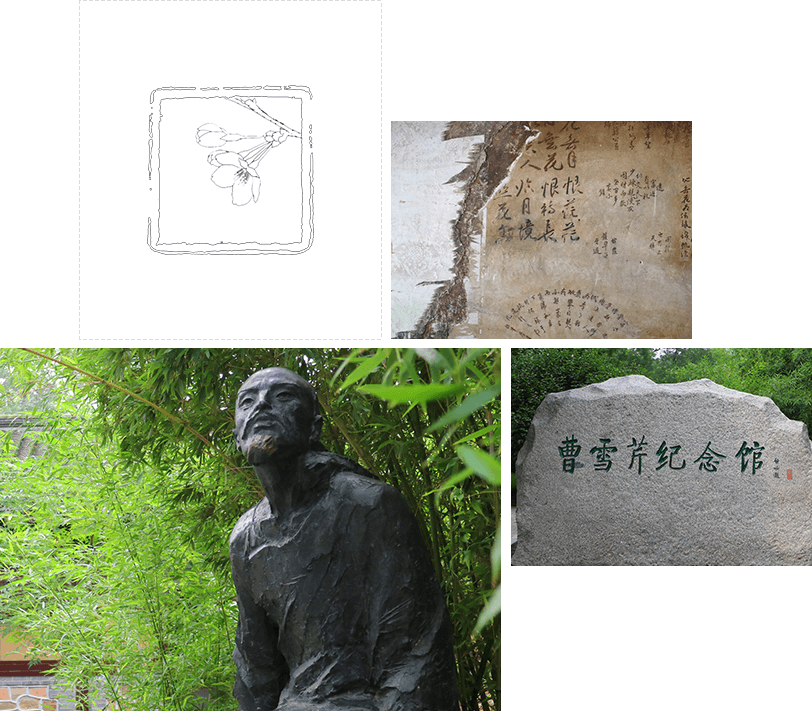
Memorial Pavilion of December 9th Movement
Completed on December 9th, 1985, the memorial pavilion is designed by teachersstudents of Architecture Department of Beijing Industrial University. It consists of three small triangle pavilions. The major pavilion is 5.5m highthe side pavilion is 4.2m tall with side length of 1.8m. Triangle symbolizes the tents used in the military summer campthe three triangles are arranged in the shape of the Chinese character "Zhong"(众, means many people), indicating that the Chinese people are united together against Japanese aggression. On the northeast of the central pavilion is the inscription of Peng Zhenon the northwest is the monumental writing inscribed by Mr. Liu Bingsen, which has recorded the glorious history of the December 9th Movementthe significance of building this memorial pavilion.

The Tomb of Celebrities
The Fragrant Hill area, with green mountainsclean waters, is famous for its beautiful scenery. it is a longing place with auspicious geomantic omens for dignitariescelebrities. Many tombs of celebrities are located here, such as Ruiwang Fen, Liwang Fen, Gongzhu Fen,so on. There are also many tombs of celebrities in Beijing Botanic Garden, for instance, the Tomb of Sun Chuanfang, the Tomb of Liang Qichao, the Tomb of Wang Xitong, the Tomb of Zhang Shaozeng, the Tomb of Gao Renshan, the Tomb of Mao Heting, etc.. All the person buried here have had significant influence in history. These historical relicstombs of celebrities are of great importance for intuitive teachinghistory learning.
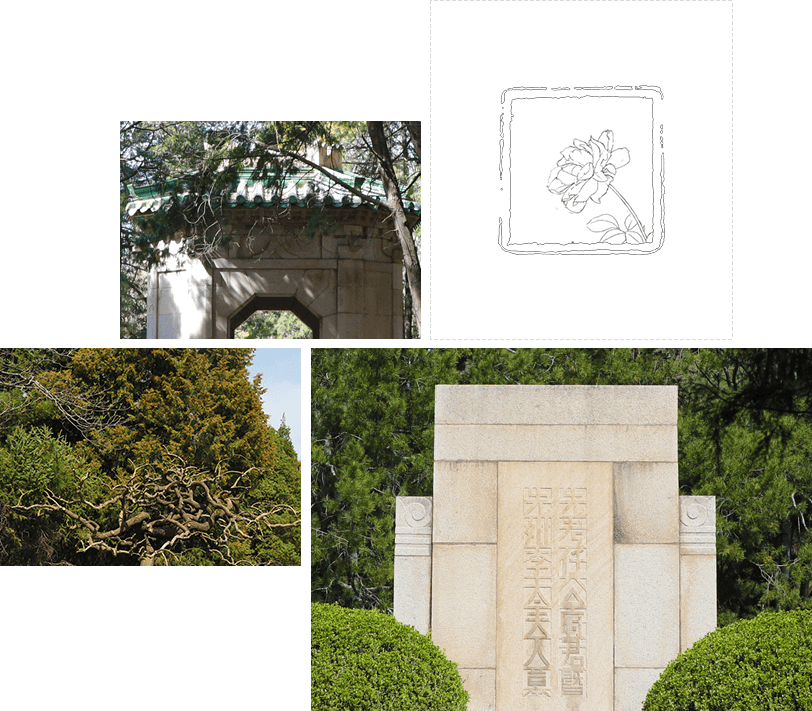
Stone Tablet Inscribed by Emperor Kang Xi
Stone Tablet Inscribed by Emperor Kang Xi
The stone tablet is in the shape of square with head of Chi on its top. The body of the stone tablet is 3.30 meters in height, 1.00 meter in width,0.32 meter in thickness, while the foundation of it is 0.8 meter in height, 1.27 meters in width,0.72 meter in thickness.
It was said that the Stone Tablet was discovered in the southeast corner of the garden (the current grape field) in the 1950s , the early years of the construction of the Garden, according to the memories of many seniors. Because it is difficult to accurately identify its inscriptionits specific age, it has been kept in the garden until now. It was included in the registration items of the cultural relics census in the third national cultural relics censusregistered as “Stone Tablet of Emperor Qianlong” by the cultural preservation department of Haidian District. Recently, it is confirm that the tablet was inscribed by Emperor Kangxi after cautiouscareful identificationverification. Since the poem was written by Emperor Kangxi when he appreciating the lotus, the Stone Tablet was placed beside the lotus pond, at the center of the Garden, for visiting of visitors. It is listed as a key protection relic.
The stone tablet is in the shape of square with head of Chi on its top. The body of the stone tablet is 3.30 meters in height, 1.00 meter in width,0.32 meter in thickness, while the foundation of it is 0.8 meter in height, 1.27 meters in width,0.72 meter in thickness.
It was said that the Stone Tablet was discovered in the southeast corner of the garden (the current grape field) in the 1950s , the early years of the construction of the Garden, according to the memories of many seniors. Because it is difficult to accurately identify its inscriptionits specific age, it has been kept in the garden until now. It was included in the registration items of the cultural relics census in the third national cultural relics censusregistered as “Stone Tablet of Emperor Qianlong” by the cultural preservation department of Haidian District. Recently, it is confirm that the tablet was inscribed by Emperor Kangxi after cautiouscareful identificationverification. Since the poem was written by Emperor Kangxi when he appreciating the lotus, the Stone Tablet was placed beside the lotus pond, at the center of the Garden, for visiting of visitors. It is listed as a key protection relic.
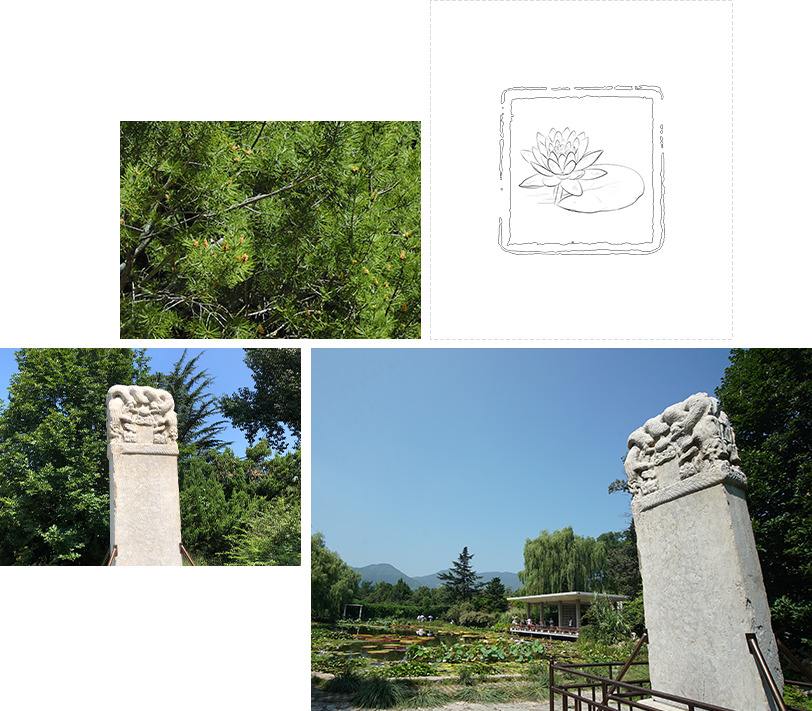
National Present
The Ficus religiosa L., a Ficus genera plant, belonging to the Moraceae family, has close relation with Buddhism. This plant of Ficus religiosa L. is a national present given by the president of India, Jawaharlal Nehru, to Chairman MaoPremier Zhou in the 1950s. It can be traced back to the Ficus religiosa L. under which the Buddha sat in meditation at that time. Now it is planted in the Exhibition Greenhouse.
The Cerasus sp., a Cerasus genera plant, belonging to the Rosaceae family, is known to the world for its beautyalso the national flower of Japan. n addition to their beautifulcolorful appearance, the Cerasus sp. in the botanical garden is also a symbol of the friendship between ChinaJapan. In the 20th century, with the increasing exchanges between the two countries, the normalization of Sino-Japanese diplomatic relations was finally realized. In 1976, Kakuei Tanaka, the former Japanese Prime Minister, presented China with 100 Cerasus sp.Larix sp.. Some of them are planted in the RareEndangered Plants Areastill flourishing although over 40 years past.
Besides, there are Olea europaea Linn.(given by Chairman of Albania, Mehmet Ismail Shehu, to Premier Zhou), Bougainvillea brasiliensis Raeusch.the Guzmania sp., (given by HồChí Minh, Chairman of Vietnam,the Vietnam embassy respectively). Now they are planted in the Exhibition Greenhouse.
The Cerasus sp., a Cerasus genera plant, belonging to the Rosaceae family, is known to the world for its beautyalso the national flower of Japan. n addition to their beautifulcolorful appearance, the Cerasus sp. in the botanical garden is also a symbol of the friendship between ChinaJapan. In the 20th century, with the increasing exchanges between the two countries, the normalization of Sino-Japanese diplomatic relations was finally realized. In 1976, Kakuei Tanaka, the former Japanese Prime Minister, presented China with 100 Cerasus sp.Larix sp.. Some of them are planted in the RareEndangered Plants Areastill flourishing although over 40 years past.
Besides, there are Olea europaea Linn.(given by Chairman of Albania, Mehmet Ismail Shehu, to Premier Zhou), Bougainvillea brasiliensis Raeusch.the Guzmania sp., (given by HồChí Minh, Chairman of Vietnam,the Vietnam embassy respectively). Now they are planted in the Exhibition Greenhouse.



